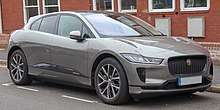Lithium nickel manganese cobalt oxides
Lithium nickel manganese cobalt oxides (abbreviated Li-NMC, LNMC, NMC or NCM) are mixed oxides of lithium, nickel, manganese and cobalt. They have the general formula LiNixMnyCozO2. The most important representatives have a composition with x + y + z = 1 and are closely related to lithium cobalt(III) oxide (LiCoO2) and have a layered structure like these. Nowadays, NMCs are among the most important storage materials for lithium ions in lithium ion batteries. They are used there on the positive pole side, which acts as the cathode during discharge.
Use of NMC electrodes
NMC batteries are found in most electric cars. NMC batteries were installed in the BMW ActiveE in 2011/2011, and from 2013 in the BMW i8.[1] Electric cars with NMC batteries include, as of 2020: Audi e-tron GE, BAIC EU5 R550, BMW i3, BYD Yuan EV535, Chevrolet Bolt, Hyundai Kona Electric, Jaguar I-Pace, Jiangling Motors JMC E200L, NIO ES6, Nissan Leaf S Plus, Renault ZOE, Roewe Ei5, VW e-Golf and VW ID.3.[2] There are only a few electric car manufacturers that do not use NMC in their traction batteries. The most important exception is Tesla, as Tesla uses NCA batteries for its vehicles. However, the home storage Tesla Powerwall is said to be based on NMC.[3]
NMC is also used for mobile electronics such as mobile phones/smartphones, laptops in most pedelec[4] batteries.[5] For these applications, batteries with lithium cobalt oxide LCO were still used almost exclusively in 2008.[6] Another application of NMC batteries are battery storage power stations. In Korea, for example, two such storage systems with NMC for frequency regulation were installed in 2016: one with 16 MW capacity and 6 MWh energy and one with 24 MW and 9 MWh.[7] In 2017/2018, a battery with over 30 MW capacity and 11 MWh was installed and commissioned in Newman in the Australian state of Western Australia.[8][9]
Properties of NMC electrodes
The cell voltage of lithium ion batteries with NMC is 3.6–3.7 V.[10] Manthiram discovered that the capacity limitations of these layered oxide cathodes is a result of chemical instability that can be understood based on the relative positions of the metal 3d band relative to the top of the oxygen 2p band.[11][12][13] This discovery has had significant implications for the practically accessible compositional space of lithium ion batteries, as well as their stability from a safety perspective.
References
- Apurba Sakti; Jeremy J. Michalek; Erica R.H. Fuchs; Jay F. Whitacre (2015-01-01), "A techno-economic analysis and optimization of Li-ion batteries for light-duty passenger vehicle electrification" (PDF), Journal of Power Sources, 273, pp. 966–980, Bibcode:2015JPS...273..966S, doi:10.1016/j.jpowsour.2014.09.078, retrieved 2020-02-23
- Wangda Li; Evan M. Erickson; Arumugam Manthiram (January 2020), "High-nickel layered oxide cathodes for lithium-based automotive batteries", Nature Energy, Springer Nature, 5 (1), pp. 26–34, Bibcode:2020NatEn...5...26L, doi:10.1038/s41560-019-0513-0, ISSN 2058-7546
- Zachary Shahan (2015-05-07). "38,000 Tesla Powerwall Reservations In Under A Week (Tesla / Elon Musk Transcript)". CleanTechnica.
- "Batterie - Beschreibung von Batterietypen. Lithium-Ionen-Batterien". Go Pedelec! (in German). energieautark consulting gmbh. 2010-10-27.
Die meistverbreitteste Li-ionzelle auf dem Markt ist die Lithium-Nickel-Mangan-Kobalt-Oxid-Zelle (Li-NMC) mit einer Nominalspannung von 3.6 V je Zelle.
- Jürgen Garche, Klaus Brandt (2018), Electrochemical Power Sources: Fundamentals, Systems, and Applications: Li-battery safety (1 ed.), Amsterdam, Netherlands: Elsevier, p. 128, ISBN 978-0-444-64008-6, retrieved 2020-02-23
- Sébastien Patoux; Lucas Sannier; Hélène Lignier; Yvan Reynier; Carole Bourbon; Séverine Jouanneau; Frédéric Le Cras; Sébastien Martinet (May 2008), "High voltage nickel manganese spinel oxides for Li-ion batteries", Electrochimica Acta, 53 (12), pp. 4137–4145, doi:10.1016/j.electacta.2007.12.054
- Kokam (2016-03-07). "Kokam's 56 Megawatt Energy Storage Project Features World's Largest Lithium NMC Energy Storage System for Frequency Regulation". PR Newswire. PR Newswire Association LLC.
- Giles Parkinson (2019-08-12). "Alinta sees sub 5-year payback for unsubsidised big battery at Newman". RenewEconomy.
- "Energy Storage Solution Provider" (PDF).
- Peter Miller (2015), "Automotive Lithium-Ion Batteries", Johnson Matthey Technology Review, 59 (1), pp. 4–13, doi:10.1595/205651315X685445
- Chebiam, R. V.; Kannan, A. M.; Prado, F.; Manthiram, A. (2001). "Comparison of the chemical stability of the high energy density cathodes of lithium-ion batteries". Electrochemistry Communications. 3: 624–627. doi:10.1016/S1388-2481(01)00232-6.
- Chebiam, R. V.; Prado, F.; Manthiram, A. (2001). "Soft Chemistry Synthesis and Characterization of Layered Li1-xNi1-yCoyO2-δ (0 ≤ x ≤ 1 and 0 ≤ y ≤ 1)". Chemistry of Materials. 13: 2951–2957. doi:10.1021/cm0102537.
- Manthiram, Arumugam (2020). "A reflection on lithium-ion battery cathode chemistry". Nature Communications. 11. doi:10.1038/s41467-020-15355-0.
.jpg)
